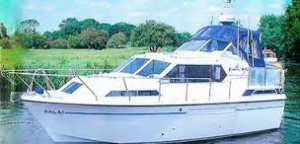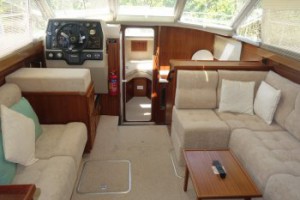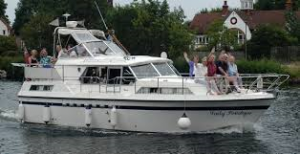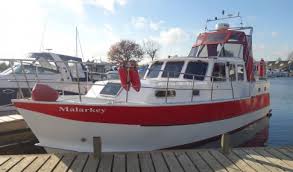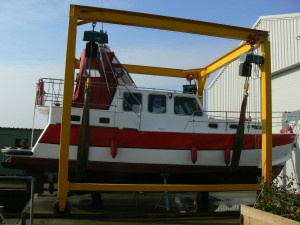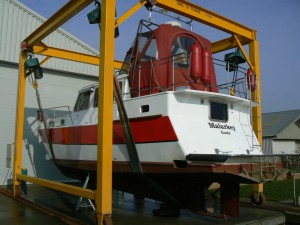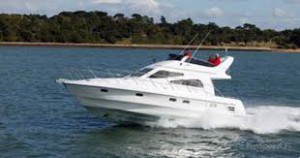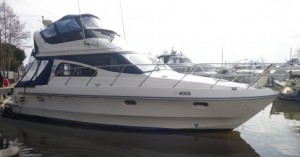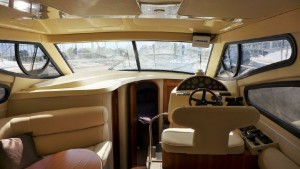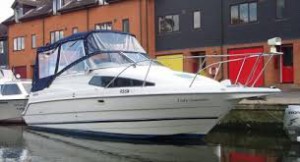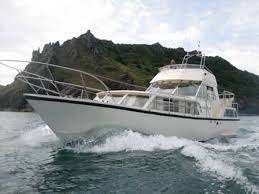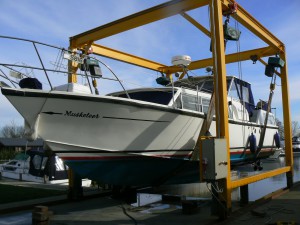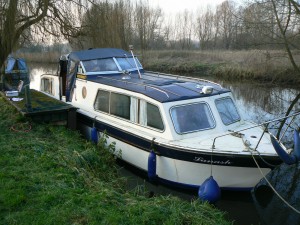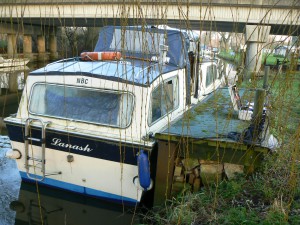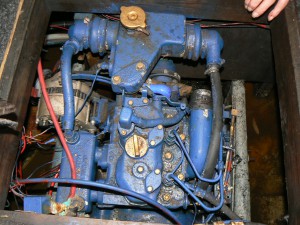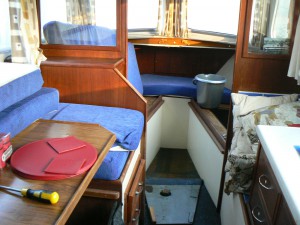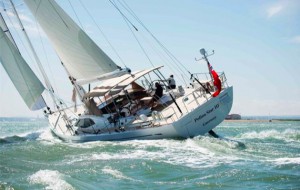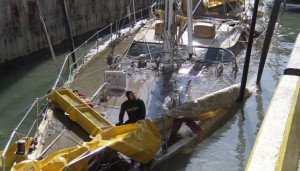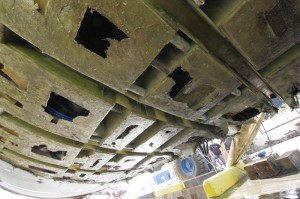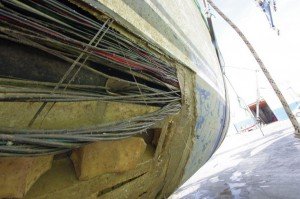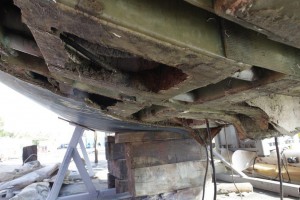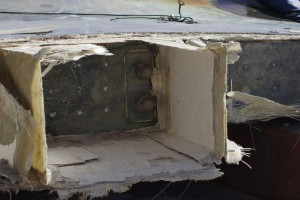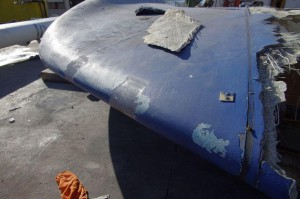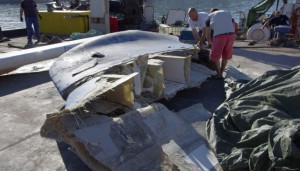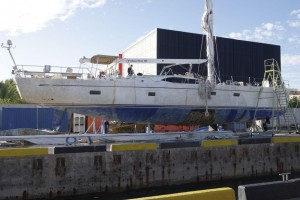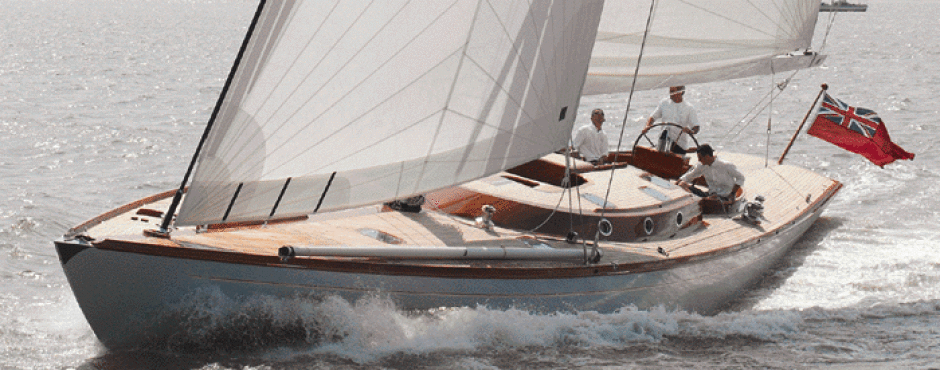
Broom 970 – Pre Purchase Survey & Testimonial # 01109August 16, 2016
Hi John
Can you please confirm if I can pay your invoice by credit card, if so, is there a charge for this?
May I take this opportunity in thanking you personally in the way Will Kirby carried out our survey yesterday. He is such a polite and approachable man, nothing was too much trouble to explain different questions that needed to be answered. He is a credit to your company and I would have no hesitation in recommending him and European Marine Services to friends and colleagues at Brundall Bay Marina.
Thanks once again.
Regards
Alan
A short synopsis to Broom Boats of Brundall, Norfolk UK
The last six years
With new direction in a growing industry, new investment in 2010 saw Broom relaunch the business in to what you see today. Redesigned by Graham Warren, the 455 and 370 models were launched with contemporary interiors and this style continues to inform the interior design of the new models.
Now in its 5th year, the Broom Boat Show sees Broom opening its doors to the public offering boat trips and factory tours, Broom is proud of its heritage and has embraced this opportunity to show their traditional manufacturing process alongside the exquisite finished product.
Broom have growing presence at a number of national and international boat shows with the Southampton, London and 2013 and 2014 Dusseldorf boat shows.
Broom 30 and 35 Coupe launched in 2012 offering Broom luxury for inland and estuary cruising (estuary cruising just applies to 35 Coupe). With a growing number of Broom registered dealers, Broom are sailing through this decade with the same passion for craftsmanship and determination for success that Charles Broom showed in 1898.
For more information contact European Marine Services Ltd. Marine Surveyors & Consultants
Tel : 01603 327 123 www.europeanmarinesurveys.com
Broom 35 European – Testimonial (#01102)July 18, 2016
Broom 35 European – Pre Purchase Survey / Testimonial
” Hi Will,
Thank you for your report. I would just like to say how impressed I am with not only with the report but the service and efficiency of yourself and European Marine services as a whole.
I will pay the invoice via bank transfer tonight. Again thank you for your help
Steve Fox “
Sent from my iPhone
Broom 35 European
The 35 European is one of the earlier models to utilise the, now classic, Broom layout of forward guest cabin, midships saloon, aft owners’ cabin with en-suite toilet and shower, and the helm on the aft deck. The galley, partly open to the saloon, and a second toilet are between the forward cabin and saloon.
All boats have an internal helm on the port side of the saloon and can sleep from five to seven people, depending on layout variations and the size of the people, with two or three single berths in the forward cabin, two singles in the aft cabin and a single or double on the convertible settee in the saloon. In addition to the door onto the aft deck, the saloon has sliding doors on both sides giving access to the side decks.
Most earlier boats were fitted with twin Perkins H6.354 diesels of either 115hp or 145hp, the latter being turbo-charged, whilst some had 120hp Ford Mercrafts. Most later boats, from 1978(?), were fitted with twin 140hp Volvos which, because they were taller, required the saloon floor to be raised several inches with a consequent change to the saloon roof, which is noticeably more ‘cambered’ on these later ‘Mark 2’ boats.
For more information contact European Marine Services Ltd. Marine Surveyors & Consultants
Tel : 01603 327 123 www.europeanmarinesurveys.com
Bruce Roberts 32 Steel Motor Cruiser – Kit (DIY) Build (#01030)
We recently carried out a Pre Purchase Survey on a Bruce Roberts Design – ‘DIY Build’ 32 Steel Motor Cruiser
Bruce Roberts Yacht Design provides construction drawings / plans for over 200 designs and plans for both sailboats and motor cruisers in GRP, alloy & steel up to approximately 85′ in length.
Bruce Roberts Yacht Design do not build boats and customers have to find their own builder / fabricator to construct. The 32′ motor cruiser surveyed had in our opinion been constructed professionally as a steel shell and then fitted out internally by third parties
The quality of the steel hull and superstructure was professional, however the internal fit-out quality left a lot to be desired
The layout had in our opinion not been given a great deal of thought with consequential loss of usable space and practicality.
Using our Cygnus 4 Multiple Echo Ultrasonic Gauge – European Marine Services can now measure steel / alloy plate thicknesses whilst the vessel is afloat – Saving you both time and money and slipway / lifting costs.
Surface Scaling / Corrosion and paint coatings are ignored
For more information contact European Marine Services Ltd. Marine Surveyors & Consultants
Tel : 01603 327 123 www.europeanmarinesurveys.com
Birchwood 360 Challenger – Pre Purchase Inspection (# 01088)June 30, 2016
Birchwood 360 Challenger – Pre Purchase inspection & Testimonial
“I have now used European Marine Services twice for boat purchase surveys. In both cases, they have been totally professional and efficient. They arrive at the specified time for the survey and are extremely thorough in their examination of the boat. If the prospective owner is present at the survey, they take the time to explain any areas considered sub-standard and advise on what might need to be done to rectify. Their report is provided as quickly as possible after the survey and is written in clear terms that are understood by anybody. Their fees for undertaking the work are also very competitive.
I would have no hesitation in recommending their services to any boat owner or prospective boat owner.
Philip Porter” # 01088-16
For more information contact European Marine Services Ltd. Marine Surveyors & Consultants
Tel : 01603 327 123 www.europeanmarinesurveys.com
In Sickness & In HealthMay 23, 2016
Hi All
Enforced Absence
I would like to express my most sincere appreciation for all the ‘get well’ comments and ‘good wishes’ received from even the most unexpected quarters.
Now back in harness albeit on a reduced working week
Will has had his hand on the tiller and expertly steered the ship
Many thanks to all
John
Bayliner 2655 Ciera | Engine Oil Analysis | # 01082
Inboard Petrol – Mercruiser 5.0L V8
Outdrive propulsion
For more information contact European Marine Services Ltd. Marine Surveyors & Consultants
EMS also undertake Boat Safety Inspections & Engine Inspections
www.europeanmarinesurveys.com
Tel: 01603 327 123
Marine Surveyor – Welcome to Will KirbyFebruary 20, 2016
 EUROPEAN MARINE SERVICES Ltd Big Welcome to William Kirby
EUROPEAN MARINE SERVICES Ltd Big Welcome to William Kirby
European Marine Services Ltd / European Marine Surveys – Are delighted to welcome William Kirby as a new Marine Surveying Associate.
William will be undertaking Pre Purchase Surveys on vessels of less than 50’ and focusing principally on GRP.
Moving from Bedfordshire at the age of 16, William followed his passion for boats & joined his parents in their new family venture of Freshwater Cruisers based in Brundall. Norfolk
Broadening his horizons, in 1999, William trained at Berkshire College to become a Boat Safety Scheme Examiner. He is also qualified as a Gas Safe Engineer carrying out LPG soundness testing, servicing & installations.
The small hire fleet soon developed into a larger scale business incorporating Marine Engineering, Boat Maintenance & General Repairs. This built up a good customer base & reputation for quality workmanship across the Norfolk Broads.
In 2014, some 21 years later it was time for his parents to retire, thus launching the beginning of William setting up on his own as Freshwater Marine focusing on Boat Safety Scheme Inspections & utilising his long established name within the Marine Industry to go forward.
In his spare time he volunteers with The Raptor Trust, rescuing & rehabilitating wild injured birds of prey as well as having his own Hawks which he flies during the winter months. He also enjoys attending motorsport events throughout the summer.
Qualifications:
- IIMS Diploma in Yacht & Small Craft Surveying. Qualified in 2004/05.
- Gas Safe Registered. Previously CORGI Registered.
- Boat Safety Scheme Examiner since 1999.
- Member of the Association of Boat Safety Examiners (ABSE)
- Full PI Insurance Cover with EMS Ltd
For more information contact European Marine Services Ltd. Marine Surveyors & Consultants
Tel : 01603 327 123 www.europeanmarinesurveys.com
Moonraker 360 – An icon from the past (# 01011)February 15, 2016
We recently undertook a PPI (Pre Purchase Inspection) of a Colin Chapman / JCL Marine 1972 Moonraker 360, which was in some ways like going back in time – A Blast from the Past
For those of you whom are interested, and to give some idea as to the background of Moonraker Marine / JCL / Colin Chapman & Lotus Cars we have reproduced the below history from www.moonrakerboats.com and acknowledge them accordingly ………..
History 1967 – 1980 In 1967 a German Rhine Army captain died before he could take delivery of ‘Moonraker’ a boat he had commissioned from Vic Bell at Brundall, Norfolk to build and fit out. The 30′ boat named ‘Moonraker’ by the buyer was an Ocean 30 (built by Aquafibre) and fitted out by Bell’s family firm – still in existence today and run by Vic’s son John Bell. The German executors asked Vic Bell to sell the boat on their behalf – the name ‘Moonraker’ was kept and the boat sold to a David Buxton.
David Buxton – a car dealer and semi-amateur racer – had been brought to Norfolk, visiting John Berry, as part of his connection with Colin Chapman & Lotus cars. Buxton changed the interior of the boat – adding a stereo and cocktail cabinet, but quickly tiring of cruising on the Norfolk Broads decided to sell Moonraker.
It was the ensuing interest in the boat and the profit he made that spurred him to set up with Vic Bell at Brundall to build six more Moonraker 30’s – without flybridge at this stage.
Having found a thriving market, it was decided to build a bigger model. Naval architect Robert Tucker (for a while he was also a Moonraker company director) designed the 36 foot Moonraker.
Despite the popularity and good sales of the Moonraker 36, the company had financial difficulties and John Berry persuaded Colin Chapman to buy the company, which he did in 1971. Lotus managers and engineers transformed the company and marketing infra-structure as well as making revolutionary changes in design and manufacturing. There was a great cross over of staff and technology between marine & automotive design and production.

Under Colin Chapman the company acquired JCL Marine and expanded the range of boats built. With Don Shead the Marauder was designed and built. Then came the so called ‘Mediterranean Models’ of Mystere, Mirage, Mamba, Mistral and the uncompleted Mangusta project.
After the company went into voluntary liquidation in October 1980, the half finished Moonraker hulls were bought by Waveney Lakes. The Moonraker moulds were bought by DC Marine who built the marque under the name Moonraker ‘Super 36’. Vic Bell bought the moulds back in 1990 and built one more Moonraker before leaving the moulds to stand on the Brundall site.
Although the Mystere / Mirage moulds were bought by Tamaris Marine – the company folded without producing any further boats.
The Mamba mould tools were sold on and at least one model produced under the ‘Falcon’ label. The Marauder plans along with the ‘Streaker’ (adapted Mamba open sports model) were sold to a company trading as Cleopatra Ltd.
We believe that the Moonraker 36 mould tools are still at Bell Boats Marina, Brundall – are they waiting for another chapter to open ?
Moonraker Models
As well as the 3 main types of Moonraker available (Sedan, Cruiser and Sports Yacht, with many variations of these also available) from 1972, coloured hulls were also available, the first being yellow. The ‘D’ series was introduced in 1973, which extended the forward cabin windows so giving greater head/standing room.
In August 1975, JCL / Moonraker Marine International Ltd became the first boatyard in the country to hold the Lloyd’s Register of Shipping Quality Control certificate. In 1976, the Moonraker 36 was the first boat to comply with and receive Lloyd’s Register Building Certificate (L.R.B.C.).
The exact numbers of Moonrakers built and sold by Moonraker/JCL between July 1971 and voluntary liquidation in 1980 are not available. Many records were destroyed when the Brundall Gardens office was hit by lightening on 15th August 1993, however surviving records show that by April 1979, 384 Moonrakers had been built and sold.
Post liquidation some half finished moulds were completed by Waveney Lakes. DC Marine then bought the moulds and competed approximately six Moonraker ‘Super’ 36. This had a much updated interior, 2 x 175hp Perkins Diesel engines and some exterior styling changes.
Vic Bell then again acquired the mould and in 1991 commissioned Excel Marine to build a Moonraker for his own use. Although planning to use this for a demonstrator for further builds, these did not happen and the Moonraker moulds remain at the Bells yard site.
For more information contact European Marine Services Ltd. Marine Surveyors & Consultants
Tel : 01603 327 123 www.europeanmarinesurveys.com
Nirvana 30 (1986) – Insurance Salvage Sale – Worth Buying (#1003)January 28, 2016
On behalf of Haven Knox-Johnson (Amlin) we recently inspected a Nirvana 30 that had sunk at its moorings consequent of vandalism, being now pumped out and now afloat
Due to a low insured value this vessel is a Total Constructive Loss (TCL) and therefore being Offered for Sale as Salvage
The engine is a 2 cyl diesel Kubota ZB750 shaft drive, and the engine has not been removed or inhibited
However, in our opinion this vessel other than (minimal) water damage is very recoverable and would be a commercially viable project
For more information contact European Marine Services Ltd. Marine Surveyors & Consultants
Tel : 01603 327 123 www.europeanmarinesurveys.com
Oyster 825 – Major Keel Failure / Polina Star 111January 23, 2016
What really happened to Polina Star 111 ?
The below is reproduced with the kind permission of Charles J Doane of Wavetrain
The genesis of this story was an incident that occurred back in July 2015 in which Polina Star III, an Oyster 825, which reportedly had been extended to 90 feet and was just over a year old, was lost off the coast of Spain. The very first report came from Oyster, but contained no details, stating only that the boat “suffered a serious incident which compromised the integrity of the moulded hull.” A follow-up report by Yachting World, published in August, added little more, noting only that Oyster believed the boat may have run aground and there were rumors it had capsized before foundering.
Oyster 825 Polina Star 111 Under Sail Polina Star in slings following salvage
In the last few days the Italian skipper of the boat has been sharing his account of the event, and photos of the wreck, which was recovered and has been closely examined, have also been circulating online. Though the exact causes are unclear, it is perfectly clear that there was no grounding and that the boat suffered from major hull delamination that led to its keel suddenly falling off.
The photographs of the damage, which have been published by a pair of German and Russian sailing publications, are staggering:
Laminate torn away Exposed wiring / services
Root of stub keel Intact keel bolts
The skipper, Alessio Cannoni, who has straightforwardly identified himself as “Alessiocannoni” in a Cruisers Forum discussion of the event, described the incident as follows:
FACT 1: (why I know what I know)
The owner built the boat with the target to sail around the world, then he asked to me to follow the commissioning, to prepare the boat for this long trip and to choose and to organize the crew. I arrived in the shipyard in the April 2014, and I stayed there every day up to the launch of the boat in July, then I have sailed on her as captain about 10.000 miles: Southampton- Norway and back, Southampton-Las Palmas, ARC rally, cruises in Caribe, Antigua-Alicante (we never arrived).
FACT 2: (the crew)
The boat had two permanent crew member, to be able to manage this aspect I have organized a turn-over of 5 people:
Alessio Cannoni
Dafne Mele
Giulia Visintin
Monica Rosini
Riccardo Salimbeni
during last trip the professional crew was: me and Dafne.
FACT 3 (the boat design)
the boat was not extended, she was designed and built by Oyster exactly as you can see in the pictures.
FACT 4: (the meteo)
we sunk in a sunny day we were reaching in 18 kn of TW with about 1.3 m of wave, sailing with staysail and 80% main sail.
FACT 5: (SHORT DESCRIPTION OF THE ACCIDENT)
3 JULY 2015 TIME 14:07′
strong noise with vibration from the hull
14:07’15”
big flooding in the engine room
14:07’30”
water over the service batteries; all systems KO
14:07’45”
I bear away, the crew prepare emergency bilge pump, life rafts, grab bags, furl manually the stay sail, send the may-day by standard-C and by VHF
14:13′
the keel disconnected completely and the boat capsized, in that moment I was standing up in front of the chart table (deck-house) sending the may-day, the water was already cooling down my balls.
a fishing boat “fished”us after a couple of hours.
Keel still attached to stub keel Broader view of keel
FACT 6:
we made a video from the life raft, it show the two rudders pointing the sky perfectly intact, a big hole in to the hull; the relic float upside down all night long, the following morning we found the boat still floating about 15 miles from the capsizing point, one missing rudder, the other one partially broken.
FACT 7:
the CEO of Oyster knows exactly this story, he sent two people on site the following day, I told them every single detail of the accident and I gave to them all the pictures and movies that I had and that I still have.
The relic of the boat and the keel was rescued in October. This operation was a month-long, I participated to this operation and I participated also to the survey performed by all the insurance company’s surveyors. We are waiting for the response.
Author’s Background – Who is Charlie J Doane ?
Charlie has worked as a boating journalist since 1986, including stints on staff at SAIL, Cruising World, and Offshore. Currently he is cruising editor for SAIL. His freelance work has appeared in Ocean Navigator, Blue Water Sailing, the New York Times, Sailing, Yachting Monthly, Yachting World, Good Old Boat, and other seemingly reputable publications.
Link – http://wavetrain.net/news-a-views/705-another-major-keel-failure-what-really-happened-to-polina-star-iii
For more information contact European Marine Services Ltd. Marine Surveyors & Consultants
EMS also undertake Boat Safety Inspections & Engine Inspections
www.europeanmarinesurveys.com
Tel: 01603 327 123





